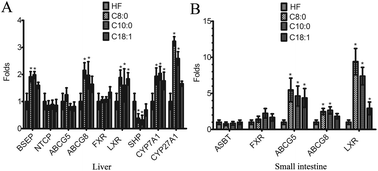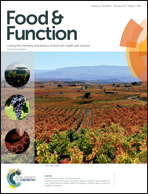Medium-chain fatty acids reduce serum cholesterol by regulating the metabolism of bile acid in C57BL/6J mice
Abstract
Hypercholesterolemia is one of the important risk factors of atherosclerosis (AS). The aim of this study is to explore the effect of medium-chain fatty acids (MCFAs) on serum cholesterol levels and their mechanism of action. Hyperlipemia, as a model of abnormal lipid hypermetabolism, was established by using a high fat diet in C57BL/6J mice. Forty eight mice with dyslipidemia were randomly divided into 4 groups, 12 mice per group, including the control group, the 2% caprylic acid (C8:0)-treated group, 2% capric acid (C10:0)-treated group, and 2% oleic acid (C18:1)-treated group. All mice were fed with a high fat diet. After 16 weeks, the mice were anesthetized with chloral hydrate. The mouse portal vein blood, the liver and the start site of the ileum (1 cm) were collected. The body weight of the mice and blood lipid profiles were measured. Gene transcription and the expression level associated with bile acid metabolism in the liver and small intestine were determined by real-time PCR and the western blotting method. The concentrations of bile acid metabolites in bile and feces were analysed. After 16 weeks of treatment, the concentrations of TC and LDL-C in the caprylic acid group were significantly lower than those in the control group (P < 0.05); the transcription and expression level of LXR, CYP7A1, CYP27A1 and ABCG8 in the caprylic acid and capric acid groups were significantly higher than those in the control group in the liver (P < 0.05), however the transcription and expression level of the small heterodimer partner (SHP) were significantly lower than those in the control group (P < 0.05); the transcription and expression level of LXR, ABCG5 and ABCG8 in the caprylic acid, capric acid and oleic acid groups were significantly higher than those in the control group in the small intestine (P < 0.05). The concentrations of total bile acid, mainly cholic acid and cholesterol in bile and feces were significantly higher in the caprylic and capric acid groups than those of in the control group (P < 0.05). Thus, MCFA increased the expression of LXR and ABCG8, enhanced CYP7A1 and CYP27A1 expression, decreased and SHP expression in the liver, thereby promoted liver bile acid synthesis and excretion. In addition MCFA increased the expression of ABCG5, ABCG8 and LXR in the small intestine, thereby inhibiting small intestinal bile acid absorption, increasing the concentrations of cholesterol and bile acid in bile and feces and reducing the level of serum cholesterol.


 Please wait while we load your content...
Please wait while we load your content...